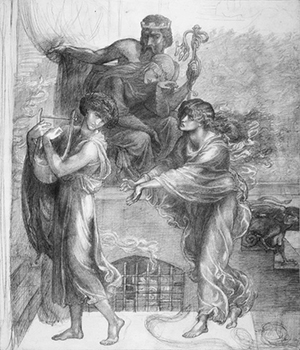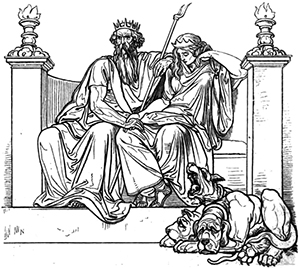speak and live,
love and receive and give…


The Hades Cycle has gone though some real growing pains in its creation. In the blog post “A Hero in Hell,” I told you how the series might never have existed at all without inspiration from writer-editor extraordinaire Alex Butcher. And I recounted the near miss averted by my first reader when she determined that an early draft of “Tale 3” was in fact a chimera of Tale 3 and Tale 4 unfortunately smashed together.
But even with those hazards safely navigated The Hades Cycle encountered two more challenges.
The first of these was its timely completion. You see, after I wrote Tales 3 and 4, I had the vague idea that it might be nice to tell Persephone’s story at some point. And then exploring events from Dís’ vantage would surely be worthwhile. But these were some day and eventually ideas. It could easily have taken me a another year or two before I got around to these stories.
But when my second reader finished reviewing my revised Tale 4, her concluding remarks to her feedback were that she absolutely was longing to get Persephone’s point of view. Her enthusiasm ensured that I tackled Persephone’s story immediately.
And, in fact, I discovered that Persephone’s situation was sufficiently complex that it required two tales to do it justice.
Once Persephone’s tales were complete, Dís himself had acquired such gravity that I could no more have delayed telling his story than I could have delayed breathing. And with Dís’ story complete, The Hades Cycle was complete. But it was not past all hazard.
 The next danger was posed by the proper ordering of Tales 3 and 4.
The next danger was posed by the proper ordering of Tales 3 and 4.
Because the chronologies of Tales 3, 4, and 5 overlap.
They each follow a different heroine. A nameless shade (it would be a serious spoiler to tell you more about her) spearheads the action in Tale 3. Tale 4 showcases Eurydice. And Persephone carries Tale 5.
But Tale 5 starts first. Partway through Tale 5, the beginnings of Tale 3 and then Tale 4 occur. All three tales run concurrently for an interval. Tale 4 ends first. Tale 3 ends at about the midpoint of Tale 5. And finally Tale 5 ends.
Confusing, no?
Check out the graphic below. I think it makes things clearer.

Now you might think that Tale 5 should have mixed itself into my series-order confusion, but it didn’t. I was always crystal clear that Tale 5 should be Tale 5.
It was Tales 3 and 4 that muddled me. Because Tale 4 (Truth) ended before Tale 3 (Hell), I thought it should come first. So much did I think this that I actually published Eurydice in Truth as Tale 3. Yikes!
It was only when I wrote the synopsis for Take from Hell, getting ready to publish it, that revelation swept though me. It was the beginnings of Hell and Truth that needed to control their series order, not their endings.
All of this was happening in the middle of November 2022.
There I was with Tale 1, Tale 2, and what should be Tale 4 up for buying and reading! But no Tale 3.
You’d best believe that I completed the publishing work on Take from Hell in record time. I’d intended to release it in January. Instead I released it the instant it was ready, on Thanksgiving!
Then I breathed a deep sigh of relief.
I believe at least one reader purchased a paperback copy of Eurydice in Truth with “Tale 3” appearing in print on the front cover and the title page. They have my profuse apologies. My only consolation is that at least they have a true collectible in their possession. It is the only copy in print like that!
But I profoundly hope that The Hades Cycle has come to the end of its bumps in the road!
May all be smooth sailing from now through the publishing of Tales 5, 6 and 7. And may my readers enjoy all seven of the stories!
For more about The Hades Cycle, see:
Hades’ Many Names
A Hero in Hell
The Reputation of Dís

Persephone Errant will release January 7, 2023!
Initially it will be available on Amazon for purchase and in Amazon’s Kindle Unlimited subscription service for free download.
Persephone Errant is the fifth of seven tales in The Hades Cycle.
Some months after the seventh tale is released, Persephone Errant will leave the KU subscription service and be available for purchase on all major e-tailers, including Kobo, Barnes & Noble, Apple, Amazon, and more.
 As I wrote the stories in my Hades Cycle, I found myself researching quite a few of the details. I knew the basics, having read and re-read the myths of the ancient Greeks from childhood on.
As I wrote the stories in my Hades Cycle, I found myself researching quite a few of the details. I knew the basics, having read and re-read the myths of the ancient Greeks from childhood on.
(I remember being particularly intrigued in my young adulthood by some modern explorations of the mythology: Goddesses in Everywoman by Jean Shinoda Bolen, Amor and Psyche by Erich Neumann, and Till We Have Faces by C.S. Lewis.)
But I have a poor memory for details (and some details were unknown to me), so I went digging.
Most of the Greek gods had multiple names, and some even a multitude. Many of them derived from the unique cultural references found in different geopolitical regions, such as Aricina, a name for Artemis from the town of Aricia in Latium.
But Hades, the god of the underworld, seemed to possess more names than any of his cohorts. Since Hades is the hub around which the entirety of my Hades Cycle revolves, his names pulled in a considerable portion of my attention. It was interesting stuff, so I’m going to share some of it with you.
Two sources seem to provide the majority of Hades’ names:
1•The change of language and culture through time, and
2•The creation of oblique epithets by people reluctant to pronounce Hades’ proper name.
I’ll explore both.
Hades through Time
The earliest form of the name was the proto-Greek Awides or Aides, dating from the late Neolithic period, 7000 BCE to 4500 BCE. Some later poetic variations may derive from that early form: Aidoneus, Áïdos, Áïda, and Áïs. The later Etruscan variant bears a superficial resemblance as well: Aita.
By classical times (510—323 BCE), the god’s name had settled to Háides, and thus it remained in Greece. This is the basis of our own anglicized Hades.
But while the Greeks recognized Háides as the god’s proper name, they spoke of him as Plouton or Ploutos (“wealthy”), and it was Plouton who was adopted by the ancient Romans as the god who both ruled the underworld and who distributed the riches from below ground. Variants on Plouton included Ploutodótes and Ploutodóter, “giver of wealth.”
Interestingly, Hades as Ploutos was given a priestess in Greece. He’d not received religious observance before, being deliberately ignored because of his connection with death.
But, moving on through time . . . we come to Orcus and Dís Pater.
Orcus was an Etruscan god, ruler of the underworld (like Hades) and punisher of broken oaths, who propagated into ancient Roman beliefs.
Dís Pater (“father of wealth”) was a Roman god presiding over fertile agricultural land and mineral wealth from below the soil. He was also called Rex Infernus (“king below”).
Just as happened in Greek culture, the Romans eventually conflated the two—Orcus and Dís Pater—but then blended them into the Greek Plouton to yield Pluto.
In both Greek and Roman culture, the underworld took its name from its ruler rather than the other way round, giving us Hades in Greece and Dís in Rome.
Just to gather them all in one place, here’s a list of all these historical names:
 Awides
Awides
Aides
Aidoneus
Áïdos
Áïda
Áïs
Aita
Háides
Plouton
Ploutos
Ploutodótes
Ploutodóter
Orcus
Dís Pater
Rex Infernus
Pluto
Epithets for Hades
The ancient Greeks, disliking death, avoided speaking Hades’ name. Even though he was not Death personified—that was Thanatos—his role as ruler of the dead in the underworld was too close for comfort. Therefore they devised innumerable alternates.
I’m not going to opine on all I discovered. Instead, I’ll give you a list (which is likely only partial, since the ancients were inventive, and not every variant was recorded):
Adesius, from Latium, meaning “grace”
Agelastus, from his melancholy countenance
Agesilaus, expressive of his attracting all people to his empire
Agetes or Hegetes (“one who conducts”)
Agesander
Agesilaos
Hegesilaus (“the god who carries away all”)
Aidoneos, from confounding Hades with King Aidoneos of the Molossi—Theseus and Pirithous attempted to abduct the king’s daughter, named Persephone
Axiocersus, the shorn god, from the mysteries of the Cabiri
Clymenos (“notorious”)
Polydegmon (“who receives many”)
Eubuleus (“good counsel” or “well intentioned”)
Hesperos Theos (“god of death and darkness”)
Iao, Hades’ name in Clares, a town of Ionia
Moiragetes, guide of the Fates
Ophieus, the blind god of the Messenians; derived from the Messenian practice of dedicating certain blinded augurs to him
Zeus Eubouleus
Zeus Katathonios (“Zeus of the underworld”)
Zeus Meilichios (“easy to be entreated,” a euphemism for Maimaktes, “the raging one, thirsty for blood”)
In Latin or Etruscan:
Altor, from alo (“to nourish”)
Februus, from februa, signifying the sacrifices and purifications of funeral rites
Feralis Deus, the cruel god
Lactum, from Sarmatia
Larthy Tytiral, from Etruria (“sovereign of Tartarus”)
Mantus or Manus, diminutive of Summanus, Etruscan
Niger Deus, black god
Opertus (“the concealed”)
Profundus Jupiter (“deep Jove”)
Quietalis, from quies (“rest”)
Rusor
Salutaris Divus, when Pluto restored the dead to life with drops of nectar from his urn
Saturnius, from his father Saturn
Soranus, his name among the Sabines
Stygius, from the river Styx
Summanus, from summus manium (“prince of the dead”)
Tellumo, derived from the treasures which Pluto possesses in the recesses of the earth
Uragus
Urgus, from urgeo (“to impel”)
In Egypt:
Amenthes, from the doctrines of the metempsychosis, signifying the “place which gives and receives,” from the belief that some vast gulf served as a reservoir of souls who arrived there upon death and in time departed to animate the newly born
That is one long list, isn’t it!
In my Hades Cycle, I chose always to refer to the underworld as Hades and to the god as Dís. Although, when I reached a story featuring mortals, I felt that Dís was too culturally wrong and branched out to Dís Plouton. 😉
If you’d like more about the lore and background of The Hades Cycle, see:
The Reputation of Dís
A Hero in Hell
 With the hot breath and snapping jaws of the hounds too close behind, he runs . . .
With the hot breath and snapping jaws of the hounds too close behind, he runs . . .
Beran creates magical marvels at his forge. Obsessed with his art, he ignores the people of his household and town. When a corrupt and jealous rival falsely accuses the smith of a dangerous crime—and makes it stick—Beran lacks allies.
Turned over to a violent religious sect for execution, Beran refuses to go tamely, but the manhunt on his heels makes escape unlikely.
Unless Beran learns to value human connection—to choose it—the hounds will tear him down in his tracks.
The Smith and the Hermit is a fairytale of my fantastical North-lands. If you enjoy the urgency of the hunt, the once-upon-a-time style of Andrew Lang’s Red Fairy Book, and that magical moment when a character embraces change, you’ll love this story of invention and resource.
Buy The Smith and the Hermit to confront isolation’s snares today!
Amazon I Apple I B&N I Kobo I Universal Link

Everyone subscribed to my newsletter will receive the password on December 4 to unlock the mini poster created from the cover of my novel Fate’s Door. The poster features evocative art by John William Waterhouse, so do get your copy!
If you are seeing this post after December 4, 2022, you can still get the password.
Just sign up for my newsletter here, and then email me. I’ll reply with the password. (You’ll also receive a free short story: Crossing the Naiad.)
Happy reading, as always!
 When Orpheus sings in Hades’ shadows…
When Orpheus sings in Hades’ shadows…
Eurydice longs for life, sunlight on her face, and her lover’s embrace. But no shade ever escapes the dark and dreary land of the dead, until Orpheus dares the undareable, confronting death’s king to win Eurydice’s freedom.
Confused and disoriented by her time in the underworld, Eurydice struggles to remember who she is, why she lied to Orpheus in life, and what she really wants after death.
But unless Eurydice learns that seeking life in the past yields only tragedy, Hades will imprison her forever.
Eurydice in Truth is the compelling third tale in the inventive Hades Cycle. If you enjoy characters who step out of myth into vivid life and ever-ratcheting tension, you’ll love this heartstopping twist on an ancient legend.
Read Eurydice in Truth to challenge darkness with song today!
Amazon

I’m super excited that Take from Hell was sitting in the number one spot this morning on Amazon’s Hot New Releases in Greek & Roman Myths & Legends. And Eurydice in Truth sat right next door in #2!
I’ve been running a sale for Cyber Monday, and my readers have been buying The Hades Cycle in droves. Thank you, dear readers!
To celebrate, I’m going to extend the discount prices another day—through Wednesday (November 30, 2022). So snap up your copies now!
Happy reading!
Edited to add: The sale is over now, but if you sign up for my newsletter you’ll get the earliest notice for the next one I run.